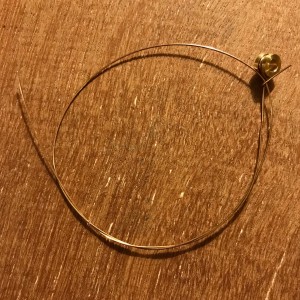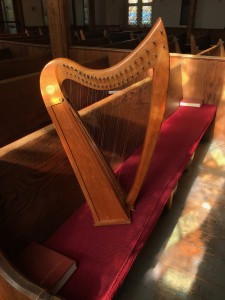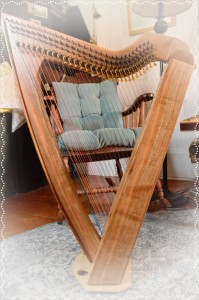At the moment my now-primary church harp is Esabelle, my cross-strung wire harp. Here she is:
She’ll need to be my prelude/postlude/Communion/hymn accompaniment harp for the foreseeable future, because:
1. She’s lightweight
2. She can be quickly carried in a nice green weatherproof bag for those torrential rainy Vermont mornings (see #1)
3. In the eight years since she was built, she hasn’t broken a single string. Not once. Knock on her walnut wood…
Sadly, my gorgeous double-strung harp will need to be out of commission for a while. This beautiful harp, less than a year old has been breaking wires lately. A lot of them. They are the original wires that came with the harp and they are very brittle. They tend to break near the top but not always. Sometimes they break near the soundboard. It happens when I’m tuning.
Wire harp tuning, I’d like to add, is not typically visible. That is to say, one cannot actually see the tuning wretch turning on the pin. It’s more like applying a slight amount of pressure to the wrench, watching the pitch change on your tuner (I have Pano Tuner on my iPhone, an excellent tuner app) and hearing the tiny increments or decrements in pitch. Usually these are quarter tones or less, a few cents, so the amount of needed displacement is very, very tiny. And it’s that small, slight lean on the wrench, that brings the wire up from an quarter or eighth of a tone flat to being right on center – when it breaks. It is, I must say, very unusual. I do test the wires before leaning on the wrench to check for the slight necessary slack. And yet…
The broken wires are very stiff. Sometimes the broken pieces shatter, like a dried-out twig in winter. I don’t know what is going on here, but I suspect this is some unusual copper-phosphor-bronze alloy, or maybe there’s some other metal mixed in that I’m not aware of.
The strings are also remarkably abrasive. One Sunday morning I needed to play louder than I normally would, to be heard, so I played close to the sound board and with a little more force. A worn away oval appeared in my right thumbnail after 15 minutes. Brittle, but hard stuff. Whatever it is.
My Triplett harp strings are very elastic and come up to pitch quickly. Also they don’t tend to have metal fatique after repeated tuning. Some of them are many years old, having been first installed on the harp when it was built in 2009 and have survived numerous tunings and changes of seasons from winter to spring and summer to fall (humidity and temperature changes will keep you busy delicately tuning a wire harp!)
I’ve been keeping a log of the breakage on my string chart and as they go, I replace them with the same corresponding string from my Triplett Luna harp. Recently a .022 diameter string broke, an E4, which is in the middle of the string band. The next lowest string down is a D4, a .026 diameter string. I don’t have one of those. Or rather I should say, I don’t have one with a brass ball end on it. So it doesn’t pull itself through the soundboard when it’s up to full tension. I do have coiled wire in that size, supplied to me by my harpbuilder and a bag of loose toggles.

Copper-Phospher-Bronze alloy harp wire with end toggle to keep it from pulling up through the soundboard.
But – this is a VERY high tension wire harp, with about 3,000 lbs. pressure on it. For a lap harp, that’s pretty high. When a wire breaks, you know it! And no, I can’t mount a tiny brass end toggle on a wire that will not tear off. I have neither the tools nor the skill/acuity for this. Triplett Harps sells their strings with the ball ends already machine wound on… I’ve been going through my harp kit bag and using up a lot of strings intended for my Luna, to replace broken strings on the new harp instead. And then reording more to replace the ones I “borrowed”.
So I recently started the hunt looking for a supplier that would provide me with suitable replacement strings. Because it’s not if these larger diameter strings will break but when.
Harp strings carry a lot of tension across the body of the instrument and in this respect, they’re a lot like a suspension bridge. Break one cable and all the other cables have to carry that much more weight. I’m not planning on breaking a large cable and expecting my higher notes to carry the load, so, time to go string shopping!
And I really, really don’t want these important big wires to break in the meantime.
I will post updates (and photos!) on my evolving wire harp wire story. Stay tuned.


